
Visions.
Dynevor Centre for Art, Design and Media
May 19, 2023
–
June 16, 2023
This is a moment of great celebration!
A moment to celebrate the unique path that our third-year students have travelled, with online teaching and digital experiences through Covid, and the first degree show open to the public inside the art school since the pandemic began. This exhibition reflects how each student has found their creative voice, not simply in terms of materiality but also conceptually and philosophically.
Whilst society was ‘on pause’ during Covid, our students continued working with a wide range of materials and media, embracing new ways of expressing themselves through digital platforms and new technological processes. Our course reflects the diversity of the broader visual art world, encouraging experimentation, broadening approaches, and taking on challenges with confidence. Noticeably this academic year, our students have welcomed collaboration as an approach to practice and these important dialogues may be witnessed alongside individual artworks within the exhibition.
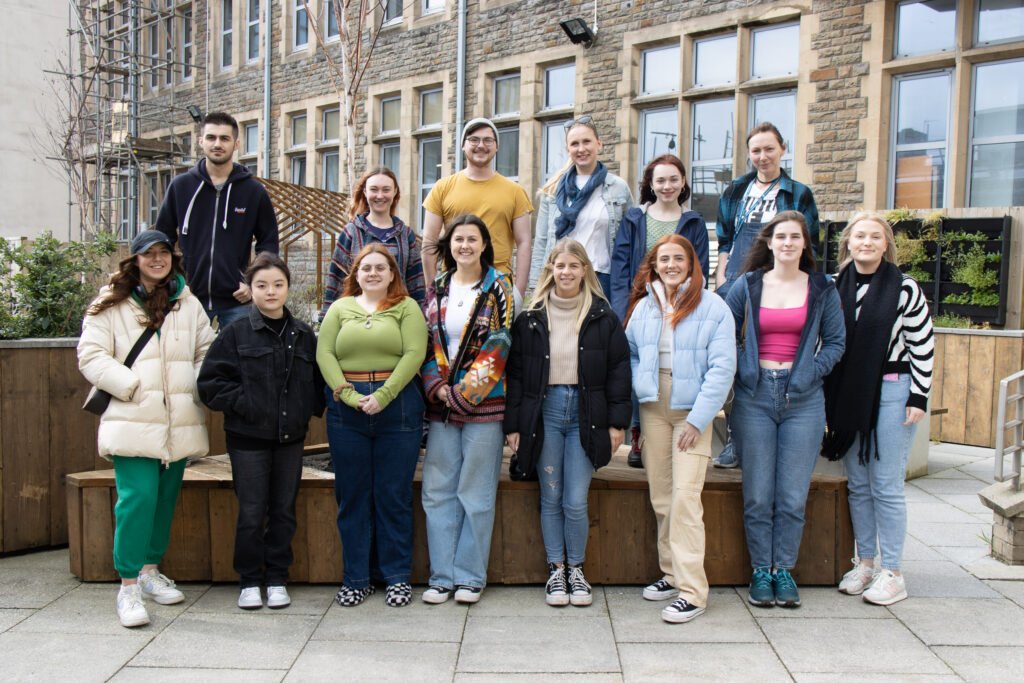
I have observed a considerable strength, resilience, and humour within our third year, both as individuals and collectively and this is reflected in the dissemination of their practice. Works will reveal both personal and public perspectives in response to the unprecedented times we are living through. It goes without saying, but I am going to say it anyway, that the visual arts play a vital role in the documentation of world events, a role our students perform with creative integrity.
On behalf of the Fine Art Team, we wish our students a very successful degree show and our best wishes for their future endeavours… added to which it must be said … you will be missed!
– Professor Sue Williams, BA (Hons) Fine Art Programme Manager
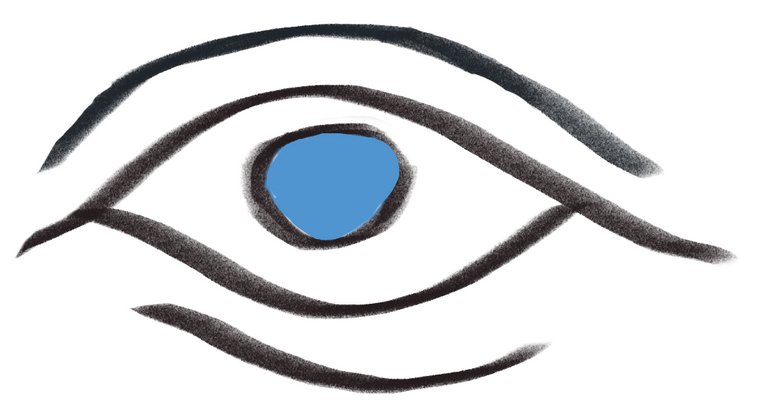

Bethan Allen
Bethan’s work throughout this year has compared modernised architecture to abandoned architecture using photos, drawings and collage. On noticing a lack of nature around modernised buildings and the use of specific saturated colours to deter from the fact that nature has been controlled around these environments, she started to investigate further into what the local councils and government were doing regarding this. Through her investigations, Bethan was drawn to the issues of homelessness and how they try to deter the homeless from settling into the urban landscape by adding unnecessary obstacles to these public spaces. Bethan’s work brings the inside out and the outside in, contrasting economic comfort against poverty. Making you question ‘Where do you want to sleep tonight?’

Ryan Billen
Ryan is an artist who explores landscape art, being inspired by the tranquillity of the hills and forest that surround the picturesque village where he lives. Ryan experiments with a range of materials and works across a variety of mediums including drawing, photography, digital and lino print. While out walking in the mountains Ryan uses nature and the outdoor space to draw inspiration for his artwork. Experimenting with photography and videos, Ryan captures images of old ruins and scenes of natural beauty, often during different weather conditions, he then prints them off and transforms them into lino prints. Although the lino prints are not completed in great detail they still capture the subject matter and make them obvious to the viewer’s eye.

Antonia Clenciu
Originally from Romania, Antonia works with mixed media, working with painting, various textiles, clay sculptures, and written works. Her practice explores religious themes in a variety of contexts, as well as examining representations of women from biblical iconographies or mythological legends.
Antonia uses her practice as a reflection of her insecurities and anxieties, often analysed through self-portraiture. Coming from a religious and traditionalist culture, her works have a certain spiritual element, from the mystic masks that her figures often wear, to the symbolist flow that is always present. Through her works, she asks questions about belief and self and unravels the work’s sacred mysteries.
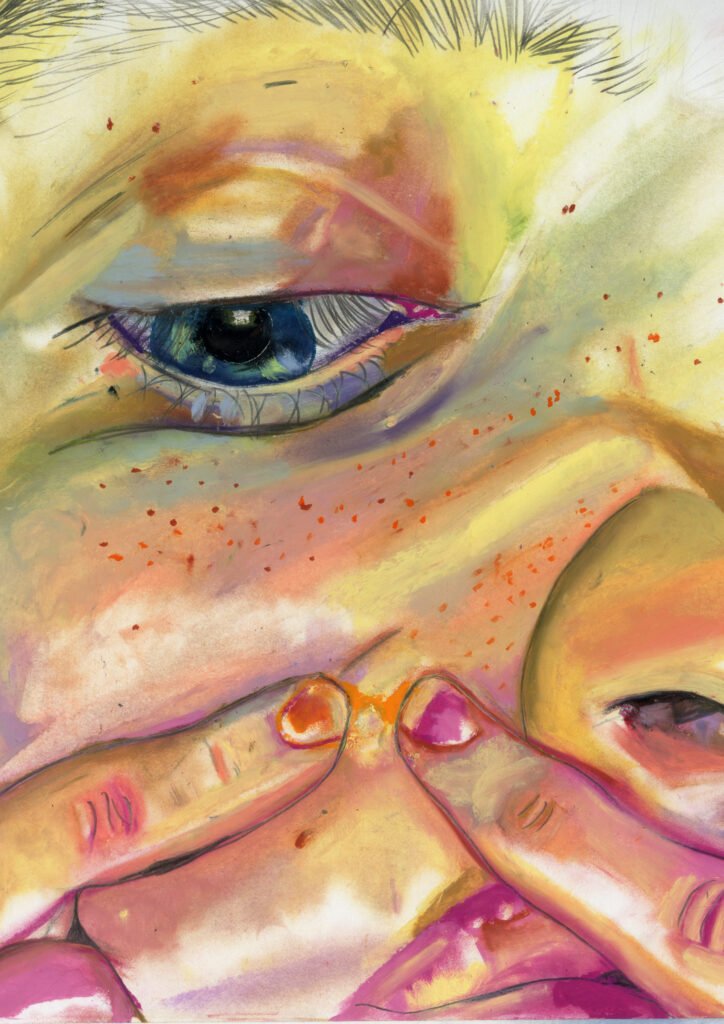
Charis Copp
Charis is fascinated by the graphic and grotesque; her practice specialises in exploring the internalised relationship we share with our bodies. She likes to express and embrace the repulsion we sometimes feel when looking at ourselves in the mirror. Her work intends to magnify this emotion and create almost monstrous forms.
Charis works predominantly with oil pastels, straddling the line between traditional figurative painting and the postmodernist desire to create work that is autobiographical in nature. She explores skin as a surface, her heavy depiction of pimples serves to actively contradict the clinical ideal of female beauty. She has no interest in creating sentimental work and instead wants to agitate and provoke. Charis produces visually challenging imagery to elicit a sense of distress and discomfort within the viewer.

Jasmine Cottrell
Jasmine’s work explores her personal relationship with darkness within her domestic environment. Her paintings portray different emotions associated with varying levels of darkness, creating an uneasy negative feeling in a dark room and a positive response in a bright room. Within her paintings she acknowledges the artificial lights from electronics around the house like microwaves, lamps, and the Wi-Fi router, suggesting they provide glimpses of comfort in a dark space. Her work has developed from a fear of the dark and through the process of painting, she circumnavigates this emotion in order to separate herself from the fear.

Dawson Edwards
Dawson strives for one thing in his art; honesty.
After spending a lot of time during the pandemic in front of a screen, Dawson now aims to continue experimenting with his hands and stoneware clay to create beautiful pieces of handheld domestic wares which allow him to reconnect with nature.
Dawson began his work with an interest in disrupting the base norms of domestic vessels. Changing the form would impact the function of the vessel in turn offering a different experience when used. However, while learning the basics of throwing on a pottery wheel, Dawson found comfort in simply working with clay which evolved into a deeper meditative process leading to a deeper connection to the work he makes. It was in this process that Dawson understood that art does not need to be overly complicated for it to be meaningful.
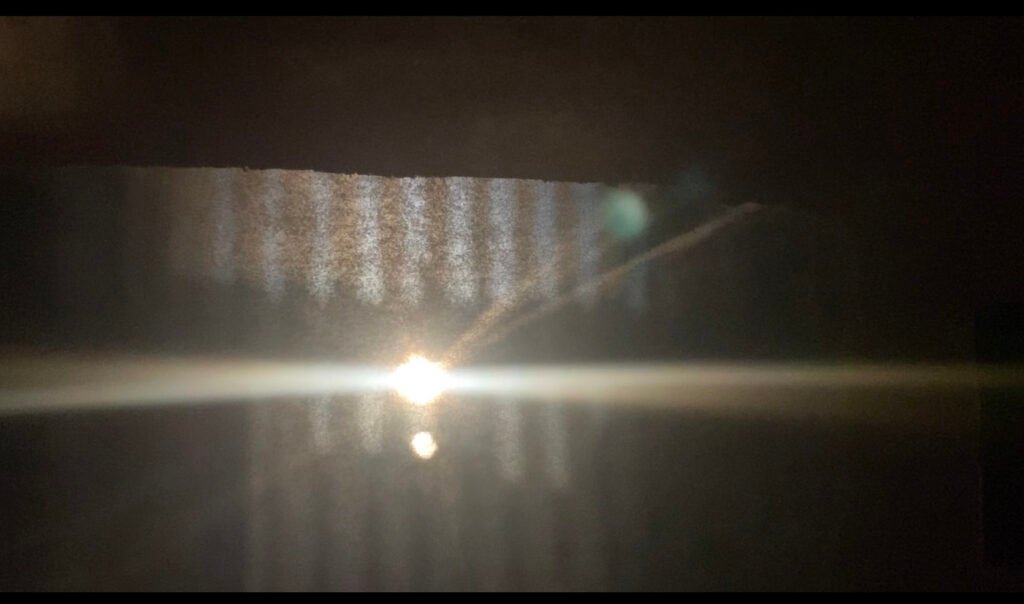
Seren Evans
Seren is a multi-disciplinary artist, who explores the notion of comfort and discomfort through space, site and sound. Their sound sculptures explore how sound can evoke memories and define a certain space.
Seren chooses spaces that have a significant meaning in her life, manipulating the lighting/sound of a space thus establishing a new perspective of the given space. She draws sounds, records sounds, documenting the chosen area for a better understanding of the space, using layering techniques to create a disorienting feeling, and to change the perception of the space.
The work sheds light on the intimate relationship we share with a certain space, that might connote comfort or discomfort. Through this process, questions are raised about the effects of noise pollution, and how it could possibly affect us psychologically and physically.

Sarah Grossey
Sarah Grossey is a multi-disciplinary artist. Her artwork has previously taken the form of sculptural works from clay and resin, covering topics of death and time, and the correlation between the two and the scars they leave on the landscape. Her current practice continues to explore similar themes of memory, delayed grief, and nostalgia. These are developed through the use of a variety of her family archives that she interprets through mixed forms of media. From photographic processes to glass, ceramics and print, Sarah is developing a body of work surrounding objects and domestic settings that are reminiscent of her family’s upbringings, as well as her own childhood. These objects have been archived through a repetition of material and pattern.
Sarah’s ideas of memory are often represented in reflection, how memories appear in the mind, as well as how we perceive them throughout our lives. What makes us think of someone? How did this make you feel? These memory lines are representative of every thought and reflection we have during these ‘flashbacks’.

Hannah Henson
Hannah investigates ceramics, sound, performance, and documentation. Depicting concepts such as the edges between natural and unnatural, human presence and absence, activism, and passivity. Gravitating towards film and sound as a means of expression.
Her most recent works explore the domestic space, routine, and memory. Driven by the feeling of absence, actualising embodiments of memory, utilising fabric soaked in plaster. Through her analysis of the home, she explores the sentiment; the experiences and objects that construct a safe place. Through the casting of personal furniture, that is heavily lived within her memory, she communicates the loss of a home. The relationship of plaster to furniture can be conjugated with Joseph Beuys’ conversation with physicality. Returning to her first home with the intent to reflect. Recorded through automatic writing, sculptures, and projection.
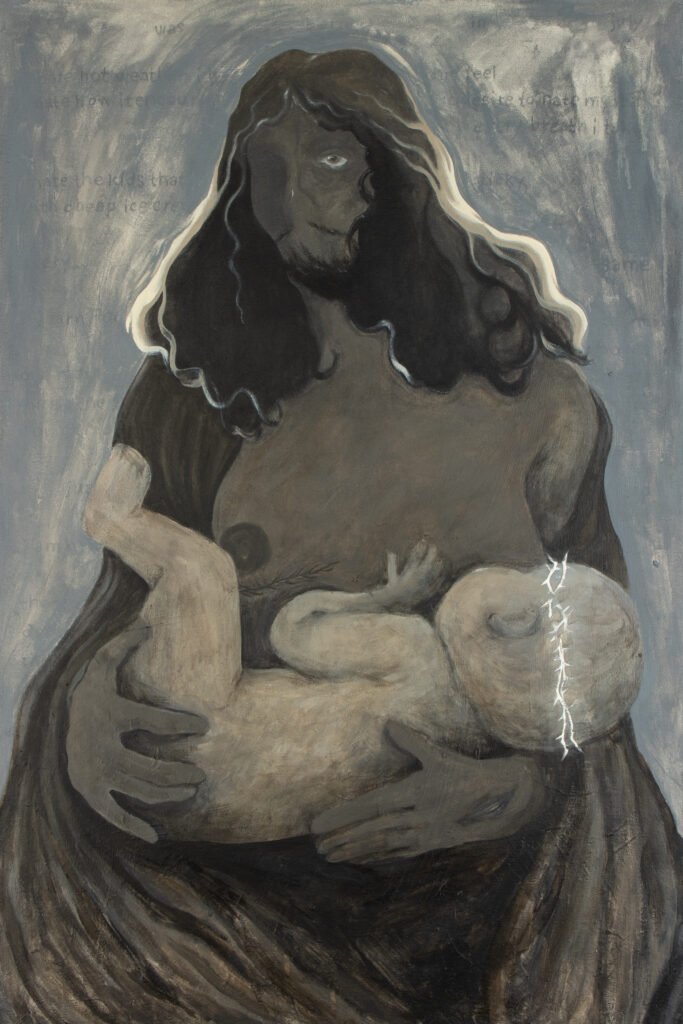
Iulia Hulea
Iulia Hulea is a Romanian interdisciplinary artist. They use wet mediums, predominantly watercolours and acrylics, as well as text to approach their desired themes, both of which are overlayed on either paper, cloth, or found, repurposed objects. The corporeality of their work comes from the self-proclaimed ”resurrection” of the materials they use, creating a connection to death and spirituality.
Drawing inspiration from queer culture and its subtle ties to Christianity, Iulia’s body of work explores biblically prohibited concepts, such as Jesus Christ’s gender identity and its links to womanhood, homosexuality, and sin. Often complete with symbols with hidden meanings, their artworks become mazes to explore and interpret based on personal experience.

Jessica Hurlow
Jess’ art practice has been an exploration into the relationships in her life. Her work focuses on the emotions involved in relationships, such as vulnerability, intimacy, and love, and these are translated into paintings. Each of her paintings explores areas of queer relationships and breaks traditional methods of portraiture based on a posed position by instead taking candid moments from her relationships that express these emotions.
Working mainly with oil paint, her style has developed to leave areas of her paintings unfinished. Playing with this technique, she uses this to highlight certain features whilst leaving areas to the viewers’ interpretation. Her more recent work is a series that explores movement in painting and an exploration into her own queer relationship.

Celyn Lewis
Celyn’s current work looks at memories, domesticity and a variety of different objects. Celyn has a fascination with everyday objects and has previously done work based on this but wanted to make her work more meaningful therefore began looking at objects that mean something to her. These objects that she focuses her work on are objects that hold special and sentimental memories to herself and her family. Each object that Celyn has collected for her work means something different and holds a different story to each person, which she is trying to show within her practice by capturing each object through creating a series of acrylic paintings. She wants to show the beauty and importance of these sentimental objects through her artwork.

Yilan Men
Yilan’s artistic practice centres around themes of gender inequality, the associated emotions and feelings, and human rights issues suppressed under centralized power. Her works are characterized by a critical perspective and political inclinations, as she delves deep into social issues within the cultural context of East Asia. She employs visual symbols and metaphors to convey multifaceted reflections and explorations. Recently, she has primarily utilized the form of posters and the medium of digital art to showcase the versatility and expressive potential of digital media. Meanwhile, oil painting and drawing are also the mainstays of her artistic expression.
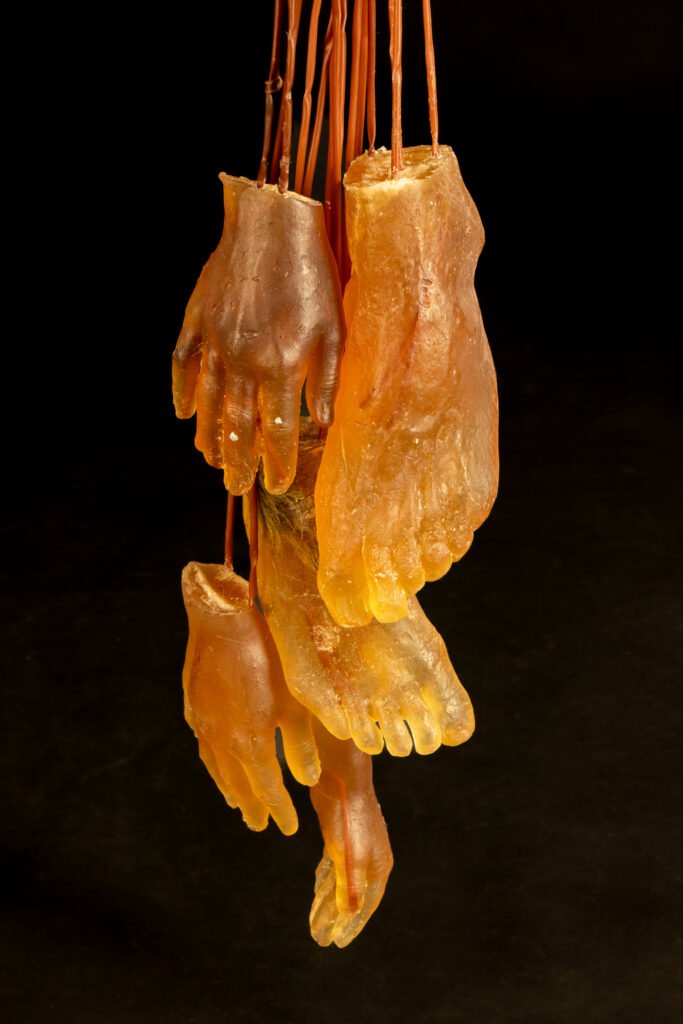
Angelika Mika
Polish-born Angelika Mika is interested in exploring unconventional techniques of painting, sculpture, site-specific and photography. Throughout her practice the concept of sustainability plays a principal role, using organic materials where possible, as well as recycling found objects, refuse, and reusable mediums such as soap and wax.
Angelika’s choice of materials reflects her commitment to the climate crisis as well as questioning the role of the artist in contemporary society. In her research and observation of close family, she highlights the disturbing phenomenon of the slow enslavement of human beings by ubiquitous technology and the absolute disconnection from nature, community, place, and time.
Angelika’s recent work questions the relationship with nature in an era of capitalism and technology and will be conveyed through installation and public participation. Her ambition is to reflect upon the importance of social change in the context of the environmental crisis.
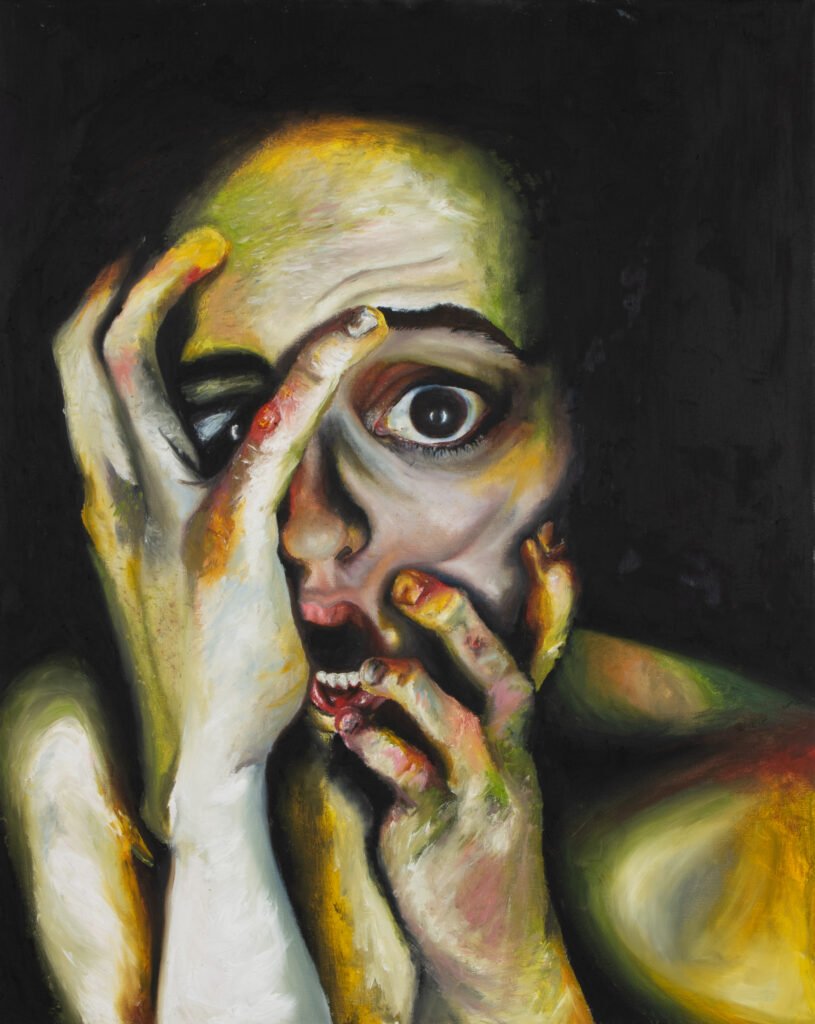
Alicia O’Connor
Alicia O’Connor is a traditional artist whose subject matter are the moments we sometimes take for granted and the challenges we face as human beings. This can range from emotions to time-related topics. Alicia explores these ideas in her paintings, drawings and video art to share how she sees the world.
Alicia’s aim for her artwork is to communicate these issues to the viewer; the way Alicia approaches these topics in her artwork can occasionally be taken as ‘brutal honesty’. This includes showing both the good and the bad things in our world, as reality never has one without the other but rather the imbalance of more bad than good over the years. Alicia carefully uses parts of her own experiences to express these problems we all face at some point in our lives.
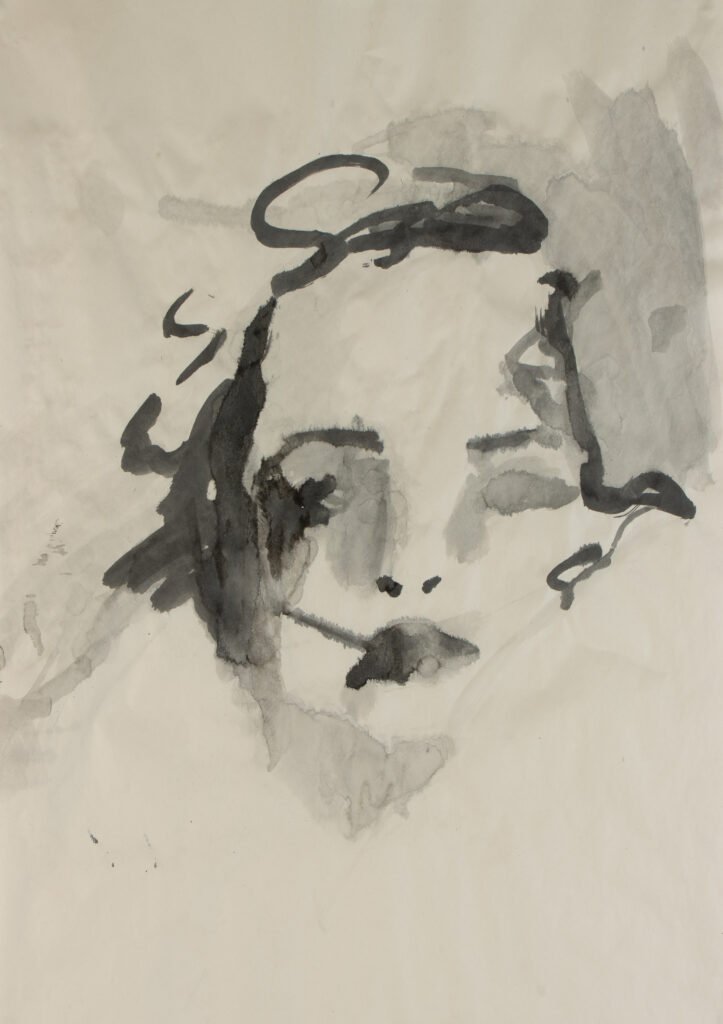
Niamh O’Dobhain
Niamh’s work explores the complexities of the ‘self’, with a focus on self-invention and expression as she is fascinated with the plasticity of the self. Her work is inspired by actresses of the Hollywood Golden Age, which led to an interest in the concept and issues of beauty and ageing.
Niamh’s recent ink drawings of imagined faces are influenced by her years of exposure to photos of Hollywood ‘glamour-shots’, stills, posters and media photos, and has developed a digital collection which is constantly expanding. She also uses makeup as a medium and turns the camera on herself, with photography being the undercurrent of her work, using it as self-reflection and an exercise in self-invention. Recent use of masks in her work explores hiding, revealing and the performativity of our identities. Her work features evolving faces; distorted, fragmented, decaying, breaking apart, and piecing together, using layering techniques. Niamh’s work is her finding what faces ‘fit’, represent, and reflect an inner and possible future self.
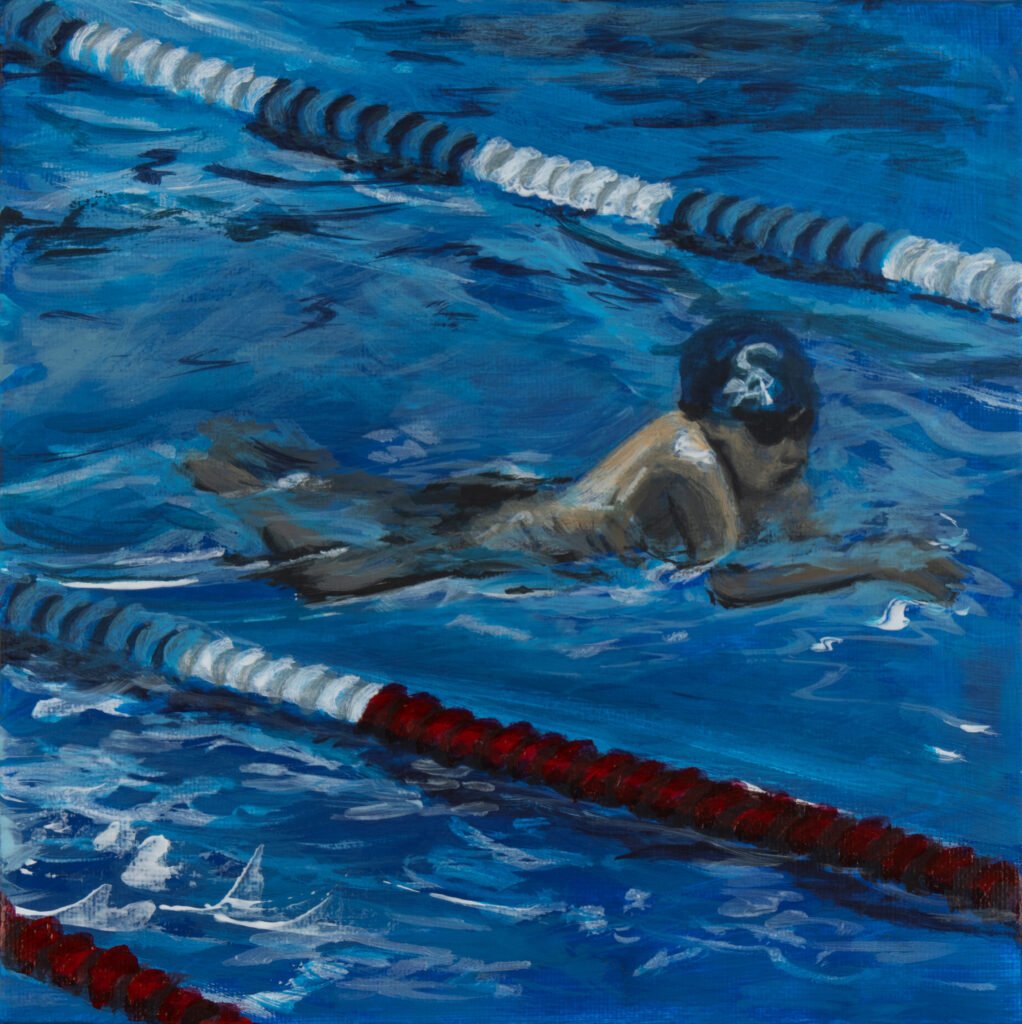
Emilia Sliwinska
Emilia investigates identity and human emotions, in relation to the urban environment. She is investigating through different media including sculpture, photography, painting and drawings. Her paintings capture the psychology of a personal experience. Through her work, she searches for the meaning of art as a translator for knowledge, mental health and a personal voice. The most recent work investigates the notion of memory and vulnerability, particularly through the movement of the body in water, where fear, passion, happiness, power, and determination is revealed through the action of swimming.
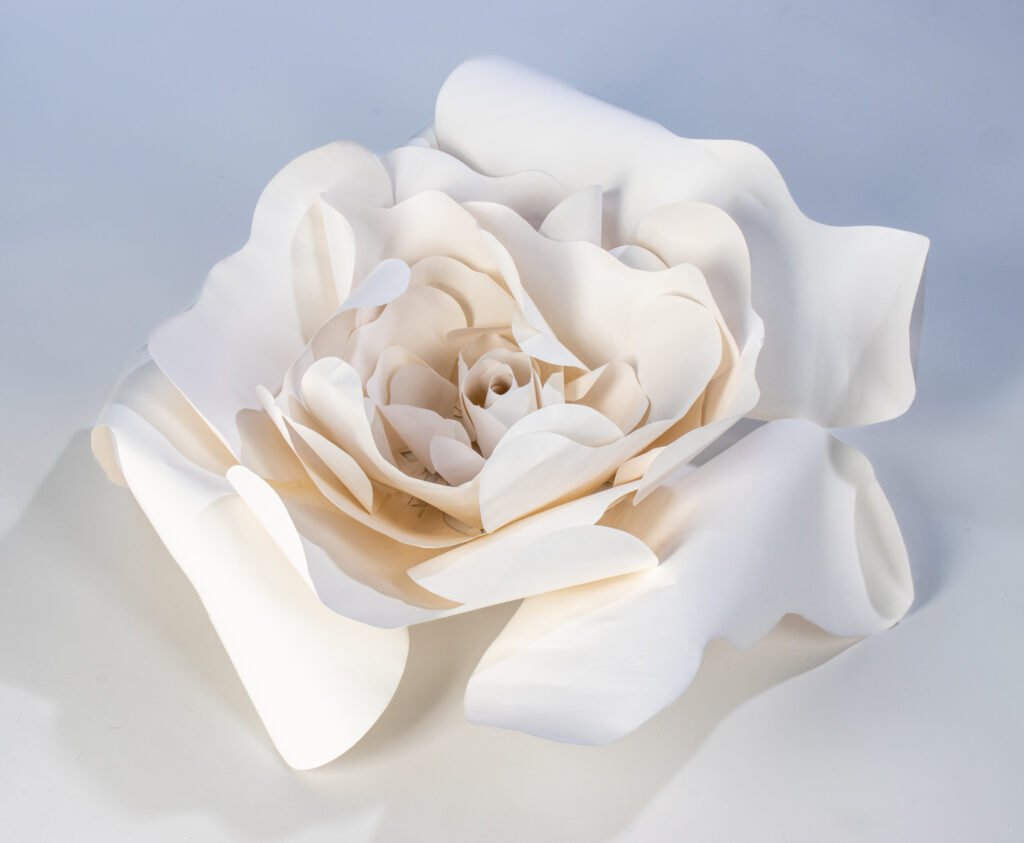
Molly Rose Summerfield
Molly explores the meaning of beauty within still-life and creates a sense of nostalgia. By using the everyday to escape the quotidian, she intends to convey that still-life is often overlooked, in both conventional and contemporary society; past and present. She is currently creating large paper flower sculptures and merging them with still-life paintings as a form of construction and deconstruction.
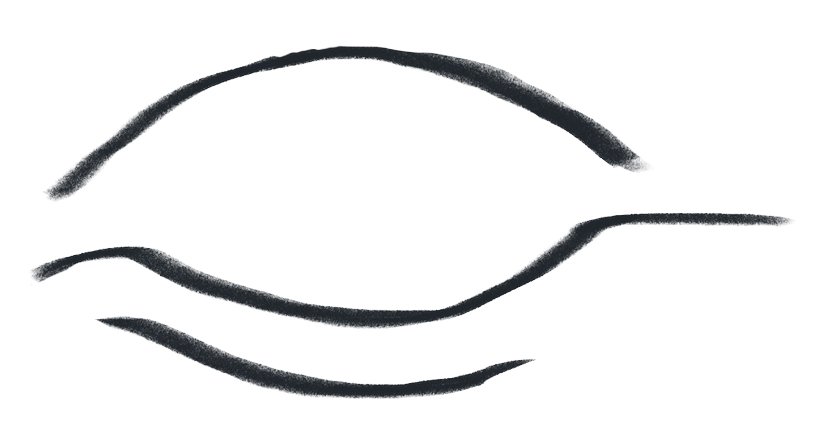
Acknowledgements
With our three-year creative journey coming to an end, the graduating class of 2023 wish to extend their wholehearted appreciation to all staff and faculty for their continued support.
We started our studies during a pandemic which brought unforeseen challenges to everyone across the department and navigating these three years through such adverse conditions would have been near impossible without their tireless dedication and encouragement.
We would like to thank Vivian Ross Smith and all visiting artists over the past three years who have provided motivation and inspiration either through a screen or in person.
We give particular thanks to Adam Shailer, Dan Butler and Lyndon Davies for all their technical knowledge and support.
Additionally, we would like to express our gratitude to other departments – such as photography, printmaking, ceramics, textiles and glass – who have supported our creative endeavours.
Finally, we would like to give a special thanks to Sue Williams, Alex Duncan, Tim Davies, Holly Slingsby and Craig Wood for their invaluable knowledge and support past and present.
It has been a pleasure to learn, work, and grow alongside you.
